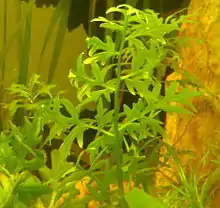Ceratopteris
Ceratopteris is the only genus among homosporous ferns that is exclusively aquatic. It is pan-tropical and classified in the Parkerioideae subfamily of the family Pteridaceae.[1]
| Ceratopteris | |
|---|---|
 | |
| Ceratopteris cornuta in aquarium | |
| Scientific classification | |
| Kingdom: | Plantae |
| Clade: | Tracheophytes |
| Class: | Polypodiopsida |
| Order: | Polypodiales |
| Family: | Pteridaceae |
| Subfamily: | Parkerioideae |
| Genus: | Ceratopteris Brongniart |
| Species | |
|
See text | |
| Synonyms | |
|
Parkeria | |
Description
.jpg.webp)
Erect aquatic or subaquatic ferns of moderate size. Rhizome short, fleshy, horizontal and ascending to erect, loosely rooted in the mud or +/- floating, radial, dictyostelic with numerous meristeles and medullary strands, young parts bearing thin, ovate, +/- cordate, clathrate scales. Fronds stipitate, the stipes fleshy, with numerous longitudinal air canals, abaxially rounded and ribbed, adaxially flattened, vascular bundles in a peripheral ring, one with each rib and several to the adaxial side, and several smaller medullary strands; lamina dimorphic, sterile fronds +/- spreading, 2 - 3-pinnatifid with broad membranous lobes, venation reticulate without included free veinlets, often with proliferous buds in the axils; fertile fronds erect, longer, narrower and more divided than the sterile, the lobes strongly recurved to completely cover the adiaxial surface, venation longitudinal, branching at the bases of the lobes. Sporangia solititary, scattered along the veins, exindusiate but protected by the continuous reflexed margin of the lamina, large, short-stalked, annulus broad, irregular, of 30 - 70 thickened cells, or lacking, containing 16 to 32 spores. Spores large, trilete, ribbed with irregular long meshes.[2]
Distribution
A widespread genus of four to six species inhabit the humid tropics.
Ceratopteris is also important in the study of pteridophytes because it is a commonly used model organism for use in genomic studies, due to the ease and rapidity with which it can be grown in laboratories, as well as well characterized phenotypes. Patented strains of this plant have been developed.
Economic use
Ceratopteris is a fairly popular aquarium plant, often sold under the name "water sprite." It may be grown as an emersed but natant (floating) plant, or as an immersed plant rooted in the substrate. Under the right conditions the plants will grow fully emersed erect leaves,but it is currently unknown as to whether it can be grown in a houseplant style soil substrate or whether the roots must remain immersed.
The most common species in use in aquaria are C. thalictroides, C. pteridoides, and C.cornuta".
Plants of this genus have also been used for food, as a green, with the common name "water lettuce." However, it is now known that these ferns are also carcinogenic if ingested.
Higher classification
Ceratopteris was long placed in the monogeneric family Parkeriaceae, thought to be unique because of its aquatic adaptations. However, recent genetic analysis has shown it to be clearly allied with Acrostichum, within the Pteridaceae.
Species
At one time, some authorities recognized only one species; now some authorities recognize only four species. However, recent work by Masuyama and Watano [3] has suggested that C. thalictroides actually consists of four cryptic species (thalictroides, froesii, gaudichaudii, oblongibloba).
- Ceratopteris cornuta (P. Beauv.) Le Prieur; Ann. Sci. Nat. 19: 103. t. 4A (1830)
- Ceratopteris froesii Brade, Arch. Jard. Bot. Rio de Janeiro 18: 31 (1964).
- Ceratopteris gaudichaudii Brongn.; Bull. Soc. Philom. 187 (1821)
- Ceratopteris oblongiloba Masuyama & Watano -- Acta Phytotax. Geobot. 61(2): 84 (-85; figs. 3-4). 2010 [Nov 2010]
- Ceratopteris pteridoides (Hook.) Hieron.; Bot. Jahrb. Syst. 34: 561 (1905)
- Ceratopteris richardii Brongn.; Dict. Class. Hist. Nat. 3: 351 (1823) - "C-fern"
- Ceratopteris thalictroides (L.) Brongn.; Bull. Sci. Soc. Philom. Paris, sér. 3, 8: 186 (1821)
References
- PPG I (2016), "A community-derived classification for extant lycophytes and ferns", Journal of Systematics and Evolution, 54 (6): 563–603, doi:10.1111/jse.12229
- Archived 2007-11-05 at the Wayback Machine Ceratopteris in Australian National Herbarium
- Masuyama, Shigeo; Yasuyuki Watano (2010). "Cryptic Species in the Fern Ceratopteris thalictroides (L.) Brongn. (Parkeriaceae). IV. Taxonomic Revision". Acta Phytotax. Geobot. 61 (2): 75–86.
- Benedict, R.C. 1909. The genus Ceratopteris: a preliminary revision. Bull. Torrey Bot. Club 36: 463-476.
- Copeland, E.B. 1942. Edible ferns. Amer. Fern J. 32: 121 - 126, pl.
- Donsellar, J. van 1969. On the distribution and ecology of Ceratopteris in Surinam. Amer. Fern J. 59: 3 - 8.
- Fosberg, F.R. 1958. Notes on Micronesian Pteridophyta, II. Amer. Fern J. 48: 35 - 39. (Ceratopteris)
- Johns, R.J. & Bellamy, A. 1979. Ferns and fern allies of Papua New Guinea. P.N.G. Office of Forests. (incl. Parkeriaceae)
- Johnson, A. 1961. The genus Ceratopteris in Malaya. Gard. Bull. Sing. 18: 76 - 81.
- Lloyd, R.M. 1972. Species delimitation in the genus Ceratopteris (Parkeriaceae). Am. J. Bot. 59: 676.
- Lloyd, R.M. 1973. Sexual and vegetative reproduction in Hawaiian Ceratopteris thalictroides. Amer. Fern J. 63: 12 - 18.
- Lloyd, R.M. 1974. Systematics of the genus Ceratopteris Brongn. (Parkeriaceae) II. Taxonomy. Brittonia 26: 139 - 160, f. 1 - 9.